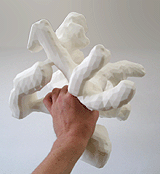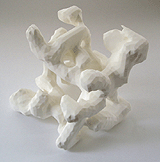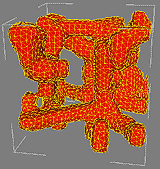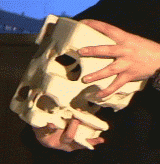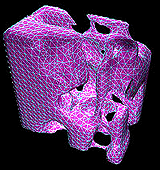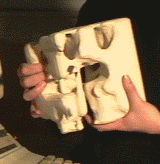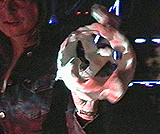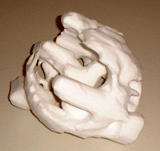|
2 |
|
work timeline |
|
data objectile / Problem Orientation Instead of Analogy. The data objectile is determined by complex factors. Its physical presence not only stands for "stable substance", but also for an unstable set of interactions, which are processed under the aspect of a multi-level conception (Varela 1990; Dupuy/Varela 1991) through self-descriptions, self-observations, and self-amplifications. And as with every articulation of art, it is a viewer arrangement, in which, in this case, humans interact with humans, machines with machines and humans with machines. At a certain degree of abstraction, it may be also said that trivial and non-trivial machines interact with one another. Generalizations, however, often tend to deteriorate into banality. In order to avoid this, the selected method must not be oriented at the most general level to characteristics or to differences in genre or to similarities, but rather to problems. First of all, it should be stressed that the data objectile results from the data generated through nybble engineering. To be more specific: it is formed through a data extract and sintered via a 3D printer (SLS method, Selective Laser Sintering). It is a 3-dimensional "freeze frame" of a real-time environment. The data objectile consequently has no reference of any kind to an object in real life. As the reference to problem orientation already indicates, the data objectile is not developed by way of analogy. Instead it is based on considerations that, contrary to classical subject-object epistemology, seek to negotiate a far more complex understanding of the object. This opens up the option of a functional equivalent that is generated in the reference to software objects and their implications in a dynamic, complex context. This, however, requires the terms specification, generalization and respecification. Like every social context, art also evolves conventionalized expectations, orders and concomitant norms. With a problem orientation, we can specify the norm more clearly by specifying the reference problem as a risk of generalization that is immanent to meaning. Shifting the norm concept to the concept of generalization puts the data objectile into a more complex understanding of the object. This is already achieved through its status of being an articulation in a communication context, where expectations always make up an important factor. These are expectations, in other words, that are guided by norms and are, to a certain extent, dependent on a factual event; thus they are "generalized expectations", which leave the content of what exactly is expected more or less undefined. Although generalization stands for indeterminacy, it does not stand for the unknown, because what defines its functionality, is that it requires respecification in order to reach reference points. In this way, it is possible to evoke an interest in intensification, which addresses cognitive expectations and thus makes generalization a precondition for learning. Of course, it is also true in this case that one must know something in order to acquire knowledge. For it is only in an open combination of knowledge contents that remain constant and the willingness to modify and alter knowledge that generalized cognitive expectations are treated as knowledge. With the definition of understanding art as an interdisciplinary coalition under specific system-immanent logics, the data objectile is targeted to the dimension of cognitive expectation in conjunction with specification, generalization and respecification. And as it is in science, the proportion of indeterminacy is made productive through the requirements of theory and method and thus referred to structures, which only apply to a specially differentiated functional system in society: in this case, the art system. In the selected method, relating problems to one another is not an end in itself, but rather serves as primary orientation in seeking possibilities, or more precisely, seeking functional equivalents. This approach makes sense, when we define the historical art context as a relation of system problems or as a way of relating them to one another. The so-called antinomy of (modern) art is only one striking example of this. In fact, however, every change of paradigms only represents the establishment of another ("new") function installation in the art system. In terms of system theory, this is part of the differentiation of function installations. In art discourse, the "new paradigm" stands for a problem construction, to which further constructions - in other words, functional equivalents - are conjoined. Orientation to function tends with appropriate complexity to higher problem specification. This applies not only to the art system as whole, with all its subsystems, which are structured through orientation to function, but also at the level of art praxis, which articulates/topicalizes/reflects/problematizes these system/environment differences. The employed method represents a special horizon of the world of life for specific intentions, which places that which happens whenever information is processed - specifically the probing of differences - under certain conditions, thus putting them into a certain form. From this perspective, the data objectile is a functional equivalent. Its functional equivalent relationship, however, does not only refer to the source text (the nybble engineering data extract) that gives it its physical form. Rather, the data objectile circulates in a functionally equivalent relationship to a cluster of art discourse types and mutual system/environment relations, which have become differentiated in the course of the historical art context in the art system. This representation is based on a premise of the General System Theory, namely that every social contact is to be understood as a system. What is essential to the functional method is its orientation to the problem of complexity and not at all to the problem of maintaining what is already there. This is simultaneously its claim to the preservation of complexity. Since the functional method is self-referentially founded in its basic complexity preservation, it identifies its semantic forms as problems of reference, which only follow their own system logic. This means that they do not mirror constructions of other realities, but rather seek to understand an ordered social reality as a form of order in relation to this social reality. The data objectile does not rely on a principle of l'art pour l'art. Essentially it is socio-technical ensembles of humans and machines that form current realities. Biogenic programs, which virtually regulate the operation of agency in the constitutional context of person, role and expectation, conjoin with programs of a technical nature. Survival means preserving complexity in a cybernetic media world. |
data objectiles 2000/01/02 |
|
|
|
|

